Unlikely as it seems, tractors have been built that are steered by reins like a horse rather than by a steering wheel. Why would you want to do that? It was not blind tradition, but a gave a way for a farmer with a lot of horse-drawn implements to use them with a tractor rather than replacing everything at once.
It also meant that one man could operate both tractor and implement at the same time; with a conventional tractor two men would be needed.
The earliest reins tractor currently known was the USA-based Hoke (of South Bend, Indiana) design in 1913; no further information has been found so far. It was followed by the Cole tractor in the same year, but again no info has been found so far. The Detroit tractor shown below also came out in 1913.
The LaCrosse Line Drive tractor appeared in 1915, followed by the Canadian Rein Drive in 1918.

THE RUMELY TRACTOR
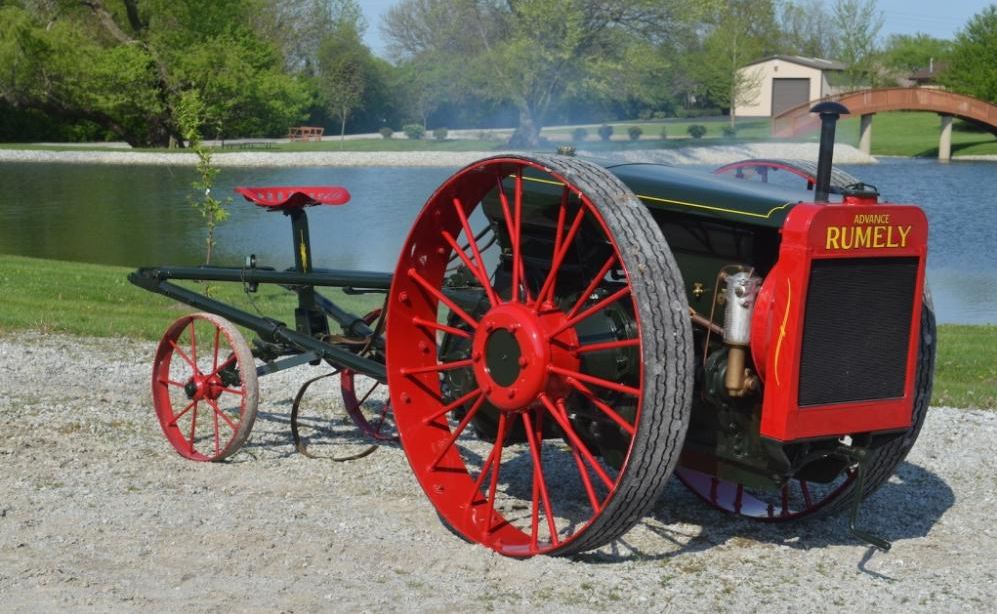 |
| Left: Rumely Line-Drive tractor: 191?
This line-drive tractor was designed by Rumely in the late 1910s. It has two separate clutches for steering, operated by pulling and releasing the reins.
The rising smoke suggests that the tractor engine is idling.
|

THE DETROIT TRACTOR
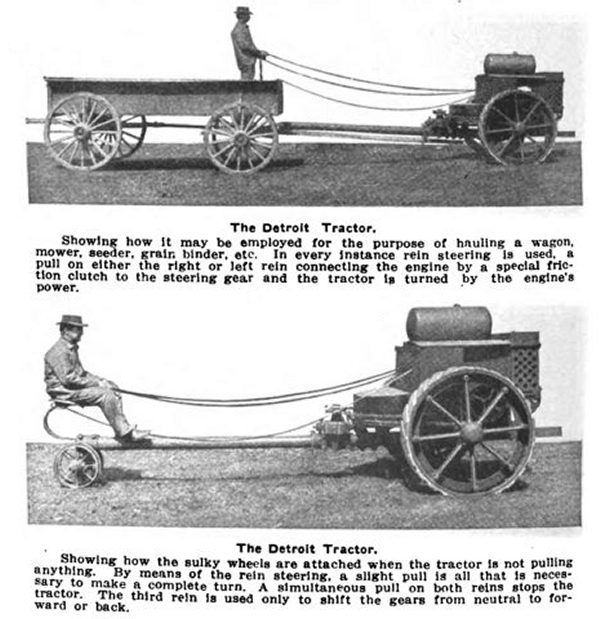 |
| Left: Advert for the Detroit Tractor: 1913
The Detroit Tractor was powered by an internal-combustion engine. It is not clear why the towing pole was so long- it may have been something to do with using unmodified horse-drawn ploughs, etc.
The Detroit Tractor Company was an overshoot of Baker & Baker of Royal Oak, Michigan. It was set up in March 1913 to build Baker tractors, but a few years later moved to Lafayette, Indiana where this machine was built. It was described as 'a line-drive tractor of the universal frame design'. Presumably 'line-drive' refers to the rein-control system, but I don't understand about the 'universal frame design'.
There is more info on the Detroit rein-guided tractor in the 5-wheel car section of the Museum.
Source: An automobile trade journal 1913
|

US ARMY ARTILLERY TRACTOR
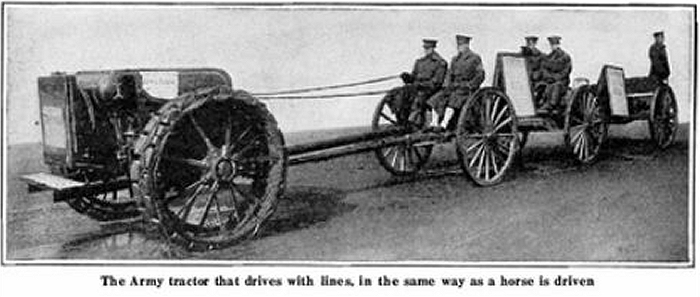 |
| Left: US Army Artillery Tractor: 1917
This artillery tractor burnt petrol or kerosene as fuel, and could go at 4.5 mph. The driving wheels were 66 inches in diameter with a 12-inch wide tread. Its weight was 5400 pounds.
Rein drive was specifically chosen to minimise the training required by men used to mules and horses. This strikes me as silly; managing a horse and and managing a mechanical tractor are completely different, so why retain just one feature, ie the reins? How long does it take to learn to use a steering wheel?
It was said to have seen service "On the Mexican border" though there is no reference to building walls, or predictions about who will pay for them.
Source: Scientific American May 1917
|

UNKNOWN STREET TRACTOR (US ARMY?)
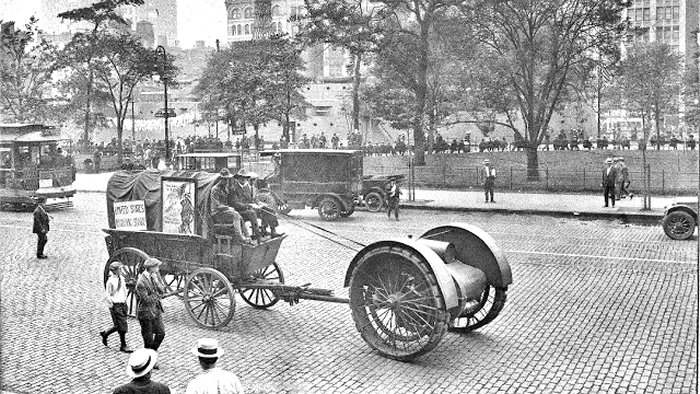 |
| Left: Unknown street tractor: 1917?
Nothing is known directly about this vehicle or the picture, but it looks like a different version of the US Army artillery tractor shown just above. The tractor looks rather smaller and more compact than most of the tractors on this page. The wheels are fitted with rubber (?) blocks suitable for street rather than farm used. It is being controlled by two reins.
The placards on the side of the waggon suggest this is some sort of publicity effort. The rear placard says "United States something something" so the location is probably an American city. (note the tram at far left)
It is probably summer; straw hats are being worn. You had to be careful about wearing straw hats in the USA. It could get you murdered.
|
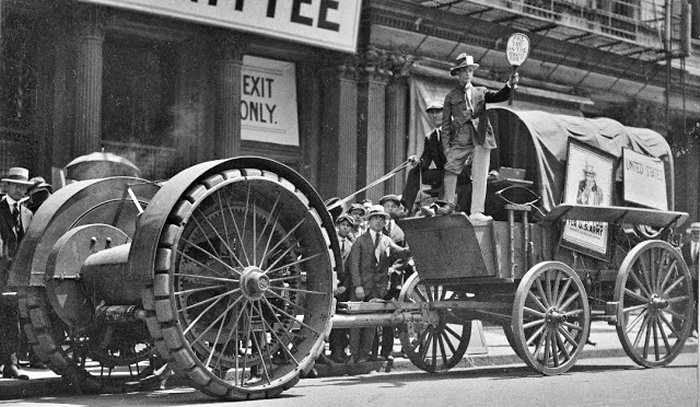 |
| Left: Unknown street tractor: 1917?
This picture makes the situation clearer. It is a US Army recruiting drive in WW1. The chap holding up the tennis racquet is in army uniform; the racquet reads "Are you in the something something". The placard at the front of the covered wagon is the familiar picture of Uncle Sam pointing out that he wants YOU for US Army.
The photograph show how the tractor was propelled; by an internal-toothed gear ring attached to each wheel and driven by an internal pinion. The circular case next to the mudguard at left contains a big gearwheel for primary reduction. There is no clue as to how the tractor was steered.
Note smoke driftng up from the idling engine, and what appears to be the exhaust silencer at the front of the tractor.
|
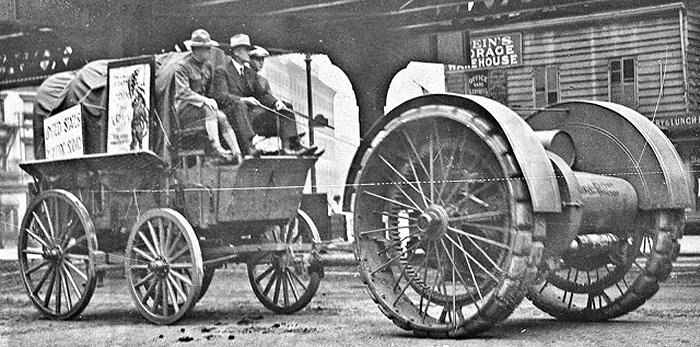 |
| Left: Unknown street tractor: 1917?
It is not clear if it was the covered wagon or the reins tractor which was supposed to be the main attraction.
I think the rear placard says "United States Savings Bond" but it is not very clear.
|

THE CANADIAN REIN-DRIVE TRACTOR
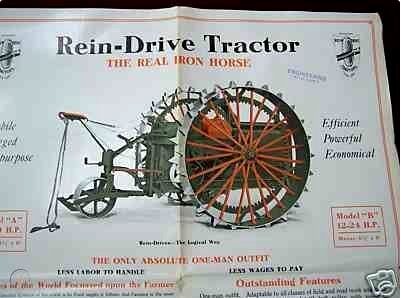 |
| Left: Advert for Canadian Rein-Drive tractor: 1918
The Canadian Rein-Drive tractor was a three-wheeled design. The traction wheels were six feet in diameter with a 12-inch tread and 24 forged spokes, and were 68 inches apart. They carried lugs on the rims that could be removed for road use. The engine was a water-cooled four-cylinder monobloc with forced lubrication, a high-tension magneto, and a centrifugal governor. The engine had a 4-inch bore and a 6-inch stroke. The transmission provided three speeds forward and three backward for each wheel. Final drive was to an internal-toothed gear attached to each wheel.
Canadian Rein-Drive Tractor Ltd was based in the Canadian Pacific Railway Building, Toronto, Canada. It was incorporated for $1 million in 1917.
They took out US patent 135,053 published 20 May 1919. It does not seem to be available via Google Patents.
|
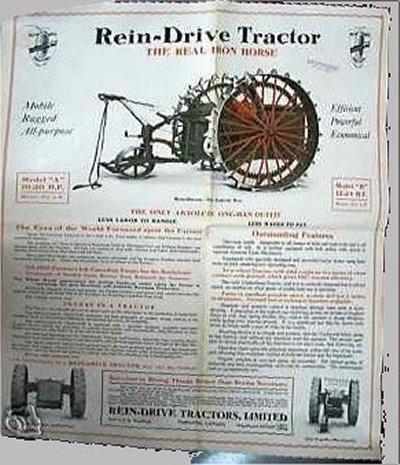 |
| Left: Advert for Canadian Rein-Drive tractor: 1918
The three speeds provided were:
Traction speed 1.5 mph, plow or direct speed 2.5 to 2.75 mph, high or road speed 3.75 to 4 mph.
Control was by four clutches operated by the reins. There was fuel tank carrying 21 gallons of paraffin, with a compartment holding three gallons of petrol for strating
There was a power take-off pulley 20 inches in diameter, which could be set to turn at 177, 335, or 634 rpm.
Unfortunately the text is not legible in this image.
|
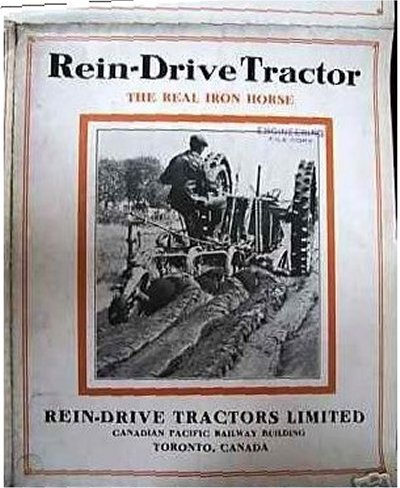 |
| Left: Advert for Canadian Rein-Drive tractor: 1918
Minimum ground clearance was 14 inches.
The cover of the pamphlet.
|
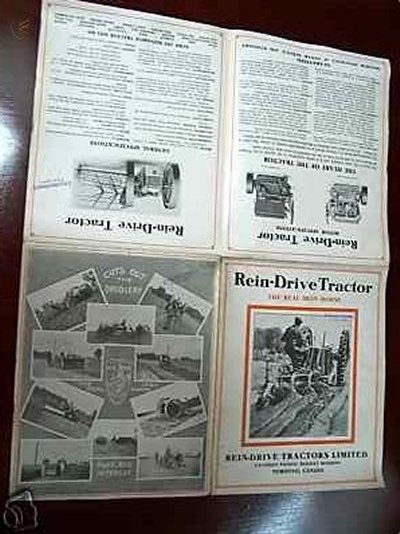 |
| Left: Advert for Canadian Rein-Drive tractor: 1918
It was claimed that with a three-bottom plow (I assume that means three blades) 10 to 12 acres could be plowed in a day.
|
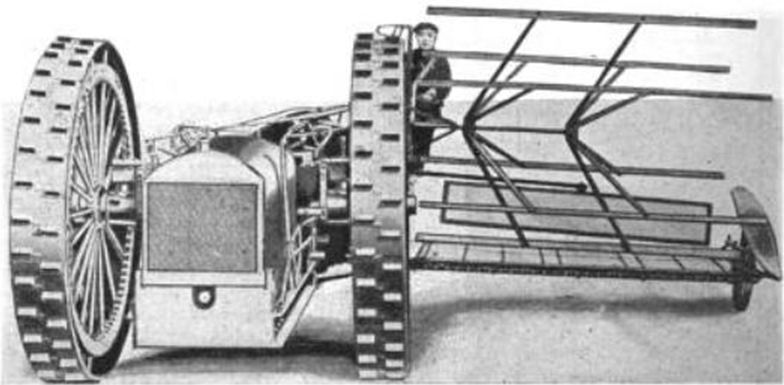 |
| Left: The Canadian Rein-Drive tractor: 1917
Here a reaper (not a reaper-and-binder) is attached to the side of the tractor. Note that most of the machinery is below the level of the axles.
This picture, which seems to be a drawing taken from a photograph, was published in The Blacksmith and Wheelwright for July 1917.
|
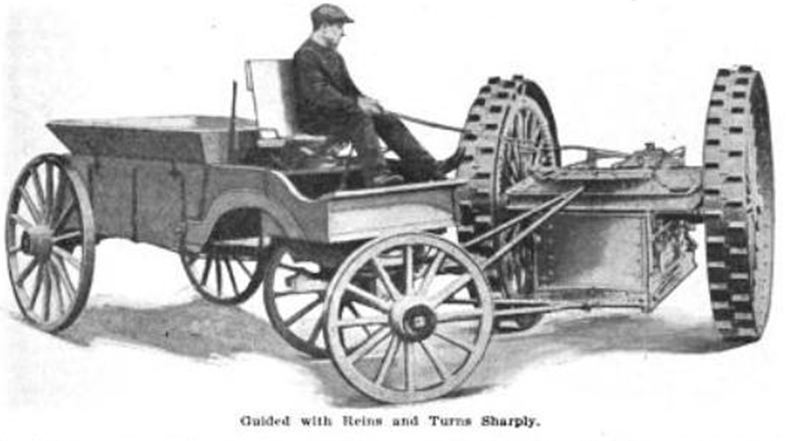 |
| Left: The Canadian Rein-Drive tractor: 1917
Demonstrating that tight turns could be made.
Source: The Blacksmith and Wheelwright for July 1917.
|
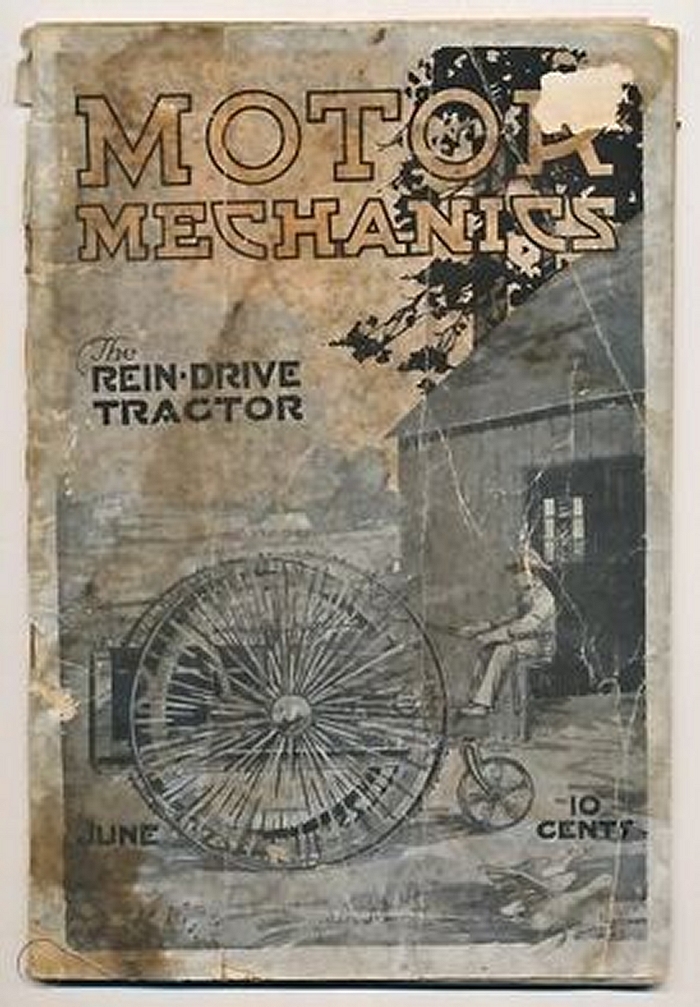 |
| Left: Canadian Rein-Drive Tractor: 1917
This is the cover of Motor Mechanics; it has not stood up well to the ravages of time.
Source: Cover of Motor Mechanics June 1917
|
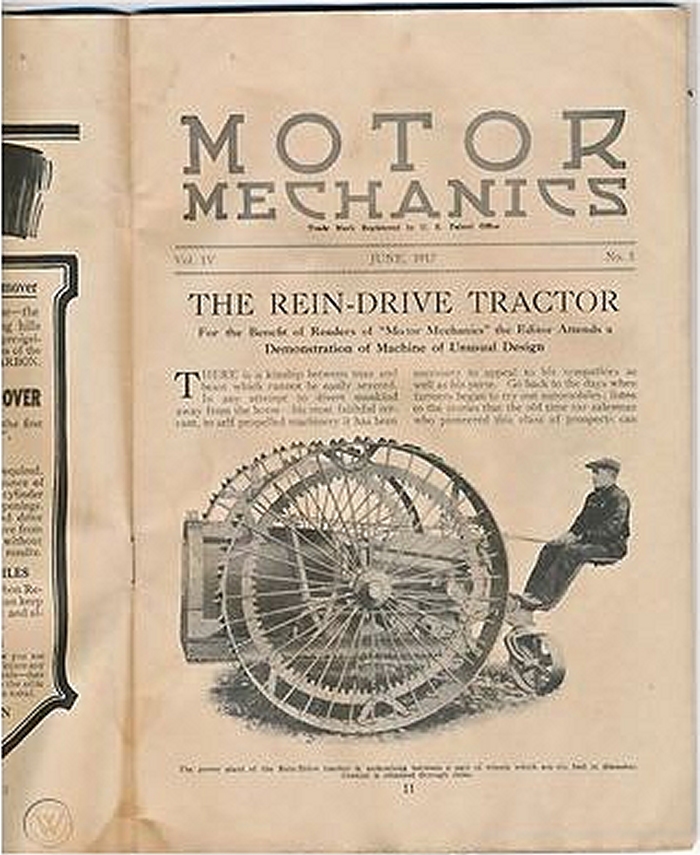 |
| Left: Canadian Rein-Drive Tractor: 1917
This is from inside Motor Mechanics. Unfortunately the most of the text is illegible.
It is confirmed that the wheels were driven by internally-toothed gears.
Source: Motor Mechanics June 1917, p11
|
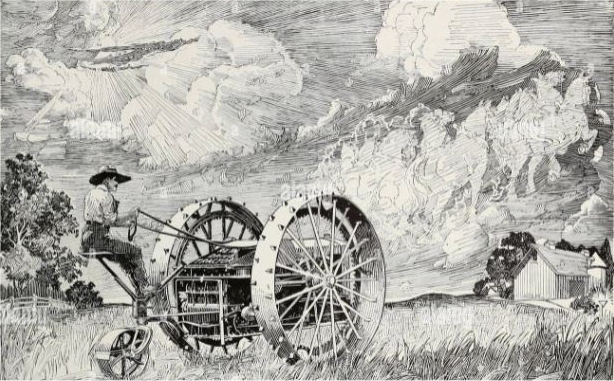 |
| Left: Canadian Rein-Drive Tractor: 1917
This looks like the same machine. Unfortunately a quiet day on the farm is being interrupted by a thermonuclear explosion at top left, and phantom horses at top right. The latter may well be Ghost Riders In The Sky.
Source: Varsity War Supplement 1917. It was published by the Students Administrative Council of the University of Toronto, Canada.
|
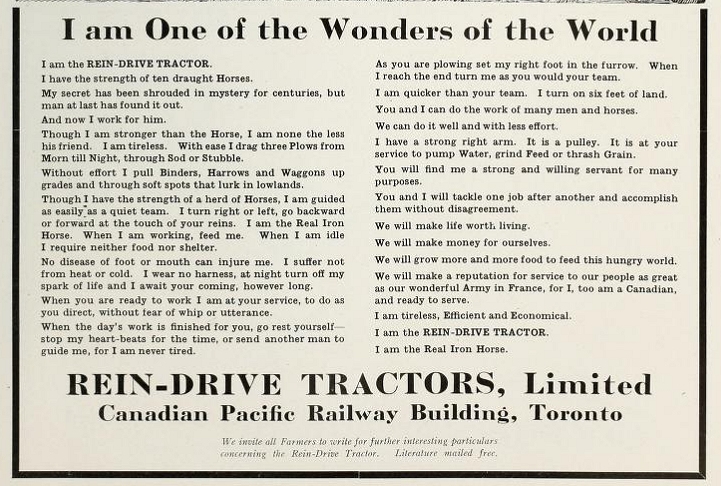 |
| Left: Rein-Drive Tractor: 1917
This is the very persuasive text that appeared below the picture above.
Source: Varsity War Supplement 1917.
|

THE BORSIG TRACTOR
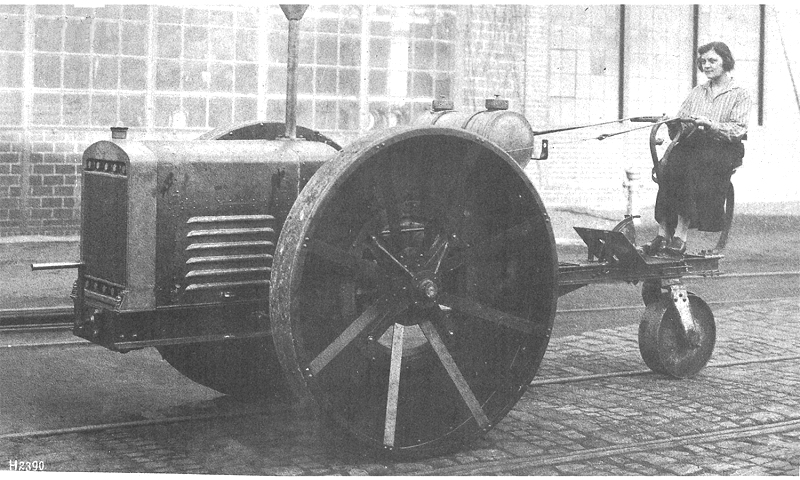 |
| Left: Borsig tractor: 1924
This machine, built by the Borsig company of Berlin-Tegel, was called the Borsig Motorschlepper. (Motor-Tractor) It was a three-wheel tractor with front-wheel drive. The Borsig company were best-known for steam locomotive and traction-engine construction. The two reins are attached to a sort of control column that sticks up between the lady's feet. Steering was by differential braking. There is also a single foot-pedal, which presumably operated the clutch or the brake. The lady is demonstrating that no great physical strength was required to control the machine.
It was powered by a four-cylinder four-stroke engine IC engine made by Kämper. Note starting-handle at the bottom of the radiator. The maximum speed was from 4.5 to 7 kilometers per hour. It had a multi-speed gearbox, though how you changed gear is not currently known. The use of reins appears to have been aimed directly at peasant farmers who were used to horses.
The whole thing looks very front-heavy, and about to pitch on its nose at any moment. Presumably it was not so.
|
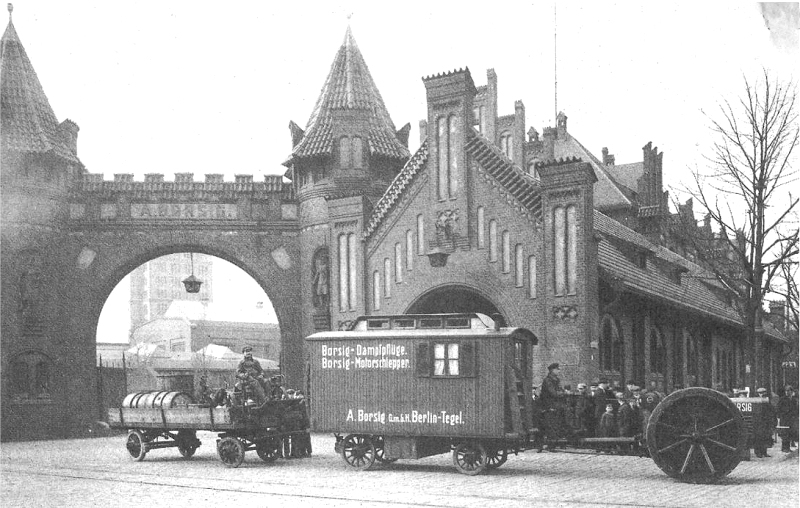 |
| Left: Borsig tractor: 1924
A Borsig tractor and trailer van leave the Borsig works, pulling another trailer loaded with barrels. The tractor was supposed to be able to haul up to 12 tons, depending on road conditions.
|
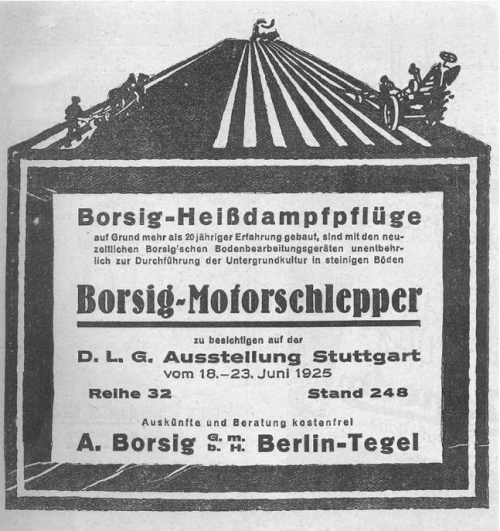 |
| Left: Advert for the Borsig tractor: 1925
Indicating it will be on Stand 224 at a show in Stuttgart. At the top is a representation of how much faster you can plough by steam and cable, which seems a bit off-topic.
|
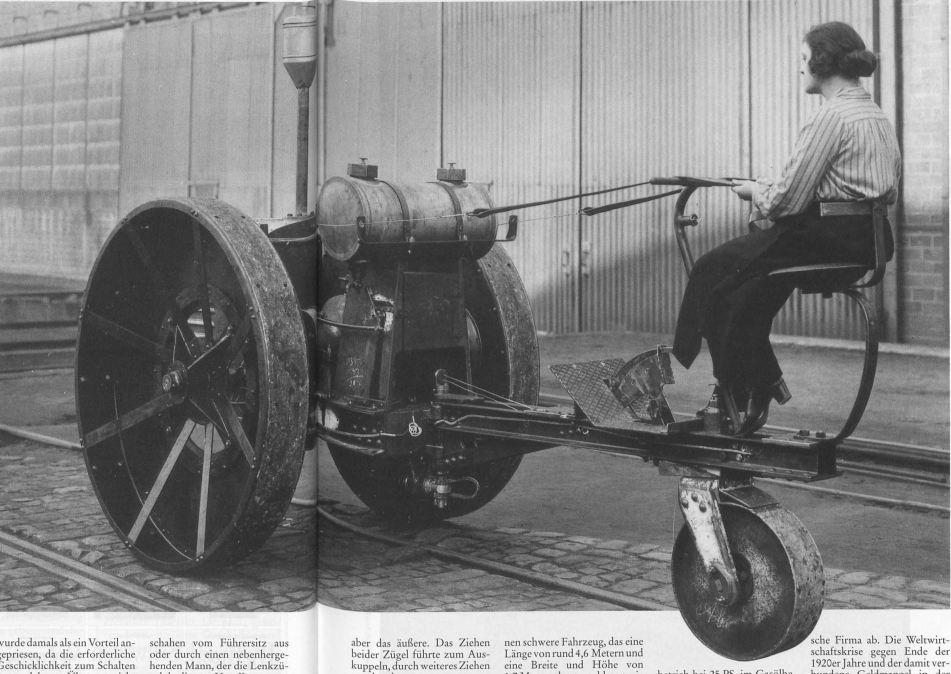 |
| Left: Borsig tractor: 1924
Another view showing a complete absence of suspension on the rear wheel. The only cushioning was the flexible steel strip holding up the seat. This was a common arrangement on agricultural machinery.
The tractor was approx 4.6 meters long, with a width and height of 1.7 meters.
The engine ran at speeds between 800 and 1200 rpm. When running on petrol or benzene it gave 25 HP, but with gas oil operation only 21 HP.
The number of Borsig tractors produced is not known.
Source: Deutsches-museum: Kultur und Technik 1991
|
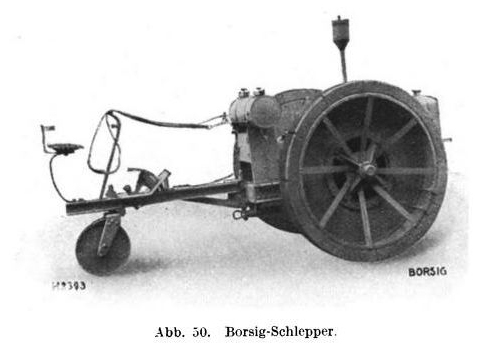 |
| Left: Borsig tractor: 1924
In this view the tractor does not look so front-heavy.
Source: Jahrbuch der Schiffbautechnischen Gesellschaft: Fünfundzwanzigster Band
|

THE LACROSSE TRACTOR
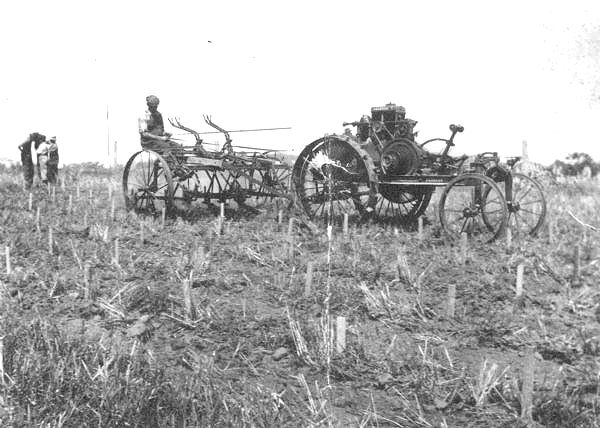 |
| Left: LaCrosse tractor with rein steering: 192?
This photograph is believed to have been taken in Wisconsin. It is definitely a LaCrosse tractor; compare the photo below.
|
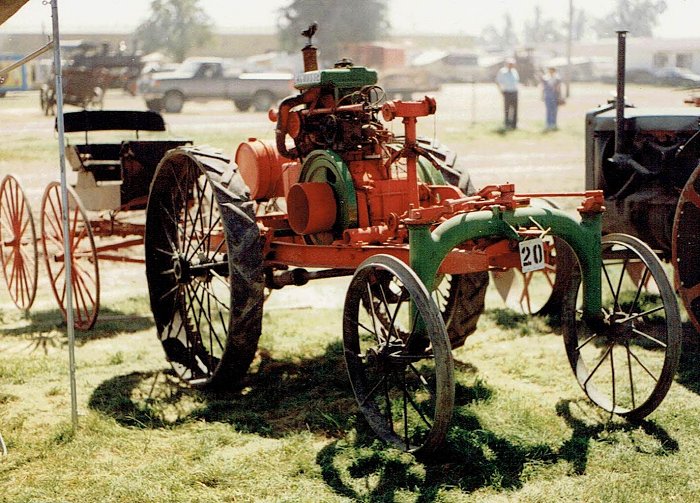 |
| Left: LaCrosse tractor with rein steering: 1919
This looks like the Happy Farmer Model G, introduced in 1919. Four lines were used for control, two for steering and two for start/stop. In reality the farmers were not happy, because the LaCrosse had a reputation for poor build and reliability.
The Model G was built on the same frame as the LaCrosse Model F. The only difference between them was the Model G had a four-wheel chassis, while the Model F was a three-wheel design. The Model G weighed 4,670 pounds and sold for about $1250, a great deal of money at the time.
|

THE FOWLER TRACTOR
 |
| Left: Fowler tractor with rein steering: 1926
This is a two-wheeled vehicle with a 32 HP water-cooled V2 engine. The pulley at bottom centre is a power take-off (PTO) that allows external machinery to be driven by a belt.
Unfortunately the photograph does not give any clue as to how the reins-steering worked. Possibly by differential braking of the two wheels.
Source: Mechanics & Handicraft Vol 5, No 9, Oct 1938
|
There is a Fowler in this museum in Australia. Only two were made, by John Fowler of Leeds, England, to the design of Cornelius Murnane of Sydney; they were shipped to Australia where it appears both survive.
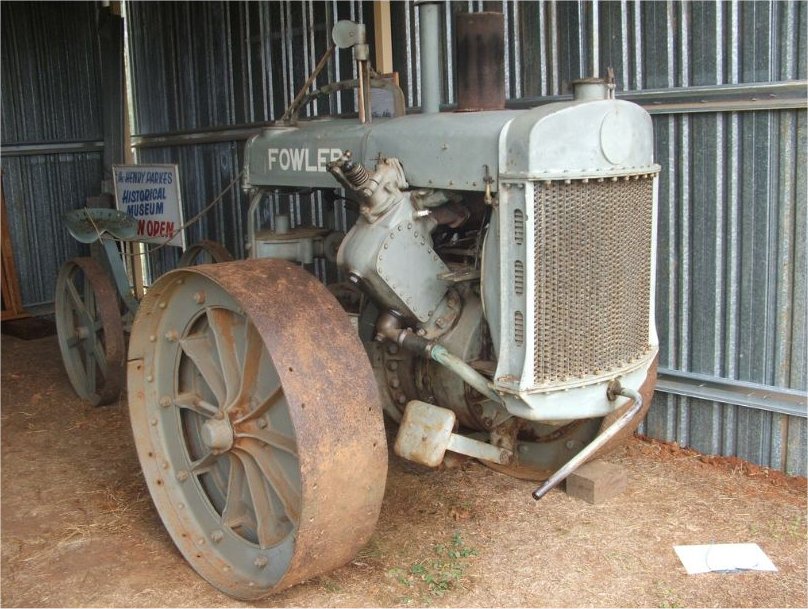 |
| Left: Fowler tractor: 1926
The sign says 'A Henry Parkes Historical Museum'. It appears to be in Australia, probably at Quirindi.
In this display a metal pole (not visible in this photograph) joins the tractor to a two-wheeled trolley with a seat. This trolley was sometimes called a sulky.
The thing looking rather like a hammer near the wheel is probably a hinged prop to stop the tractor tipping on its nose when the pole behind it was disconnected. (Thanks to Bernd for pointing this out) The thing sticking in the front looks like a starting handle, though it seems to be missing the actual handle bit.
|
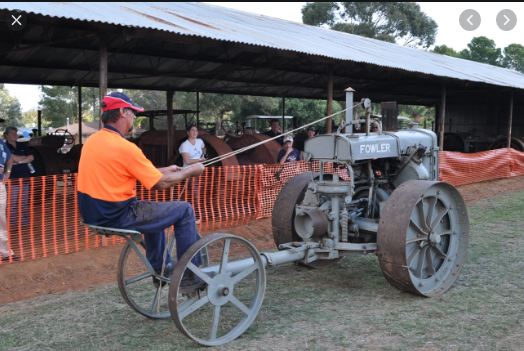 |
| Left: Fowler tractor: 1926
Here one of the two Fowlers is being demonstrated at the museum where it is kept.
|
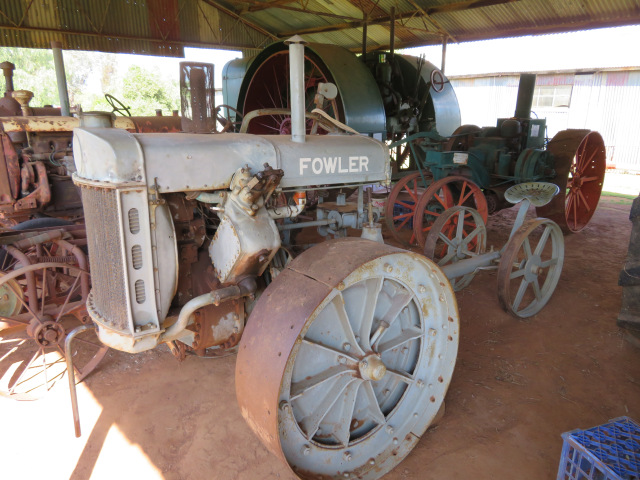 |
| Left: Fowler tractor: 1926
At rest in the museum.
|
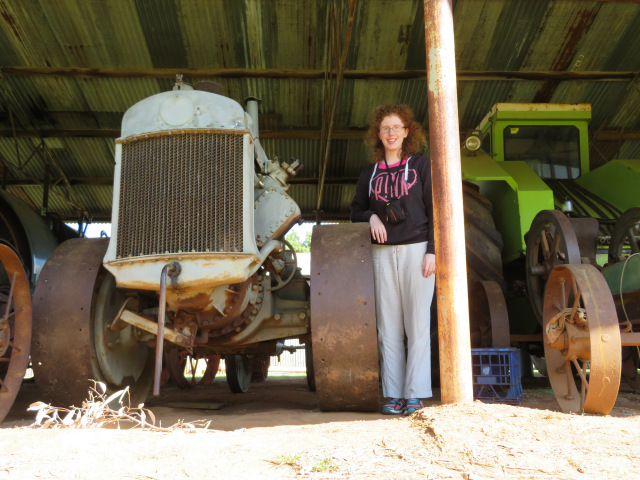 |
| Left: Fowler tractor: 1926
At rest in the museum.
|
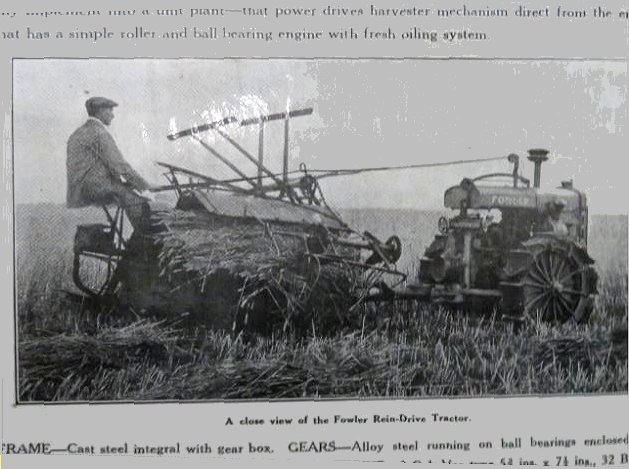 |
| Left: Advert for Fowler tractor: 1926
Here a Fowler is pulling a reaper-and-binder.
Location presumably Australia, though the tractors might have been tried out in England before they were shipped.
|

THE EIMCO POWER HORSE
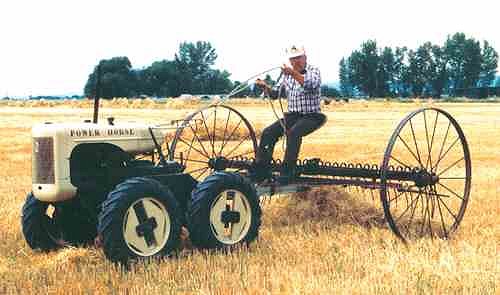 |
| Left: EIMCO Power Horse tractor: 1940
The Eimco Power Horse is probably the best-known rein tractor, with a number of examples surviving and operable. It is probably the make with the most surving machines.
Albert Bonham of Salt Lake City, Utah, designed the first Eimco Power Horse in the mid-1930s. They were only produced under the Eimco Company brand name for a few years; they were then sold under the Bonham name until 1942, when they were bought out by Allis-Chalmers. The Harris Manufacturing Company then acquired the rights in 1949 and manufactured the Power Horse until 1964.
Modern photograph
|
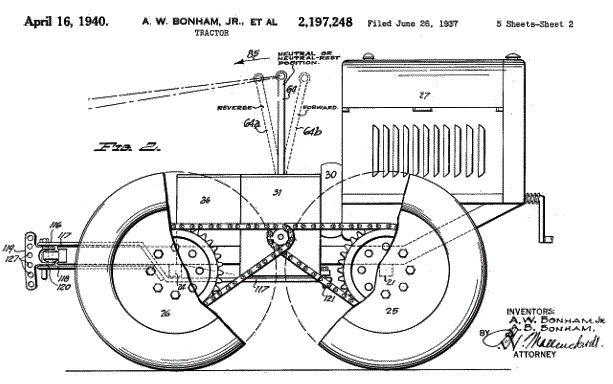 |
| Left: EIMCO Power Horse tractor: 1940
This patent for an improved design shows both axles driven by chain from a central shaft.
This drawing from US patent 2,197,248 is dated April 1940.
|
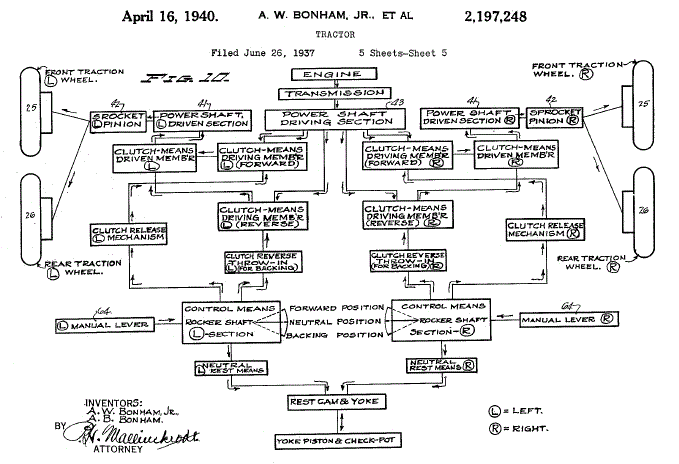 |
| Left: Drive system of the EIMCO Powerhorse tractor: 1940
According to one Power Horse restorer, the hardest part was cleaning the 23 clutches in the transmission. He said that the Power-Horse tractor has 11 clutches on each side, plus a master clutch behind the engine. This sounds like a sophisticated bit of machinery.
I thought that this diagram would give some insight into the fearsome complexity, but it does not. It is confusing because arrows are used both to represent the flow of power and the flow of information, but as far as I can make out there are only four actual clutches in the diagram, giving forward, neutral, and reverse for each side of the tractor.
Source: US patent 2,197,248 April 1940
|
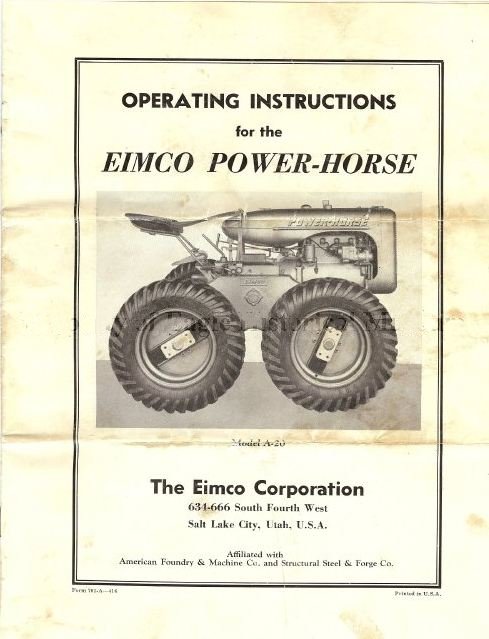 |
| Left: Manual for EIMCO Powerhorse tractor: 1945
Front cover of the Instruction Manual for the Eimco Power-Horse Model A-20.
This version has a seat; when it was used the driver operated the control levers directly.
Note the distinctive wheel design, also seen in the photograph above.
|

Other rein-guided tractors included the GMC Iron Horse introduced around 1918, and a caterpillar-tracked machine built by Dick Gauld, an upland Aberdeenshire farmer.








































